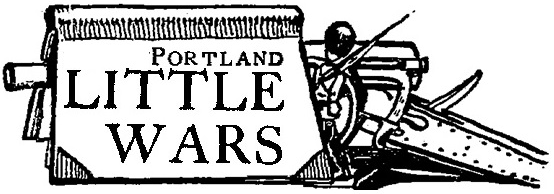Halsall's prose is very easy to read and this book seems aimed slightly more at the general public than the academic market. There are no footnotes or citations, and some of the drier probative text required in most academic books where the author has to show their work is mostly absent. In the latter instance there is little need to show probative work, because Halsall isn't really doing original research here - this is more a bibliographic overview and critique of the historical basis for a historical King Arthur.
Worlds of Arthur starts with an overview of how written and archeological sources have previously been strung together to create what is understood as the historical Arthur. Wargamers who have dabbled in Arthurian (or Subroman or Romano-British or Late Roman - choose your label) wargaming will no doubt be familiar with this version of Arthur.
Halsall then moves to a closer examination of those same sources. The written sources are rather quickly exposed as suspect, either because (1) the "sources" almost immediate start having problems with being written years after the events they describe, even centuries, (2) the author's intent is sometimes contrary to recording things factual, and (3) Arthurian-believers have basically cherry-picked the best supporting evidence and ignore what doesn't fit.
Now, many "Arthurian" wargame rulesets will actually state that a historical Arthur did not likely exist, but what's more problematic is the manner in which the imagined historical setting of a "historical Arthur" is doubtful. This is the stuff of the ignored "pleas of the Britons" and the building of forts along the "Saxon Shore" that builds up an image of a Roman Britain in crisis falling before a invasion/migration of Saxons, Angles, and Jutes. This storyline is is the prerequisite for a Briton warlord, like Arthur, to fight at Mount Badon.
 |
| Halsall notes the D-Day inferences of images like this. |
Accordingly, the balance of the book is an assessment of the historical setting of 5th and 6th century Britain and northern Europe. Was there a massive violent invasion of entire peoples into Britain? No, not really. Were professional Roman troops drained out of Britain to Gaul (and beyond) in the service of usurper generals-turned-emperors? Yes. Were these drained garrisons re-manned with "barbarian" troops (refugees, really, to use a modern context) who would gladly take the stability of regular meals and shelter in a government-supplied fort? Certainly seems so.
There is also a somewhat deep dive into what it means to find "grave goods" in a "Saxon" grave. What does it really mean that some graves have swords and jewelry etc. in them and others do not? The older, traditional interpretation is that graves with treasure are pagan Saxons/Angles/Jutes, and the graves without are Christian Romano-Britons. Halsall, convincingly, I think, breaks down this interpretation based on grave locations and dating. What made more of an impression on me was the idea that grave goods represent a society/locality that is unstable/destabilized. In a stable community, leadership will be stable, because life is good. When a community is in crisis and unstable, leadership and status will also be unstable, because the community will question its leadership. Accordingly, in a community in crisis, when a community leader dies, his or her heirs will include grave goods as a way of showing and asserting through display of symbols of wealth and power that leadership should continue in them. This may not seem like a particularly earth-shattering conclusion, but the idea of unstable or destabilized communities needing to make conspicuous displays of power has really stuck with me and I've found it a useful way to look to at early and pre-modern history outside of late roman Britain.
The ending sections of the book work to frame "Arthurian" Britain in the wider context of the Western Empire at the time (usurper emperors and the steady influx of "barbarian" troops, for example). This fits more with Halsall's specialty which is the Western Empire.
If I taught a 'Intro to History' class, I would probably assign this book, mainly for the excellent analysis of the written sources, and secondly for the analysis of archeological sources. Halsall's analysis of the written material is the practice of history at work: not only a critical reading of the source as a whole (no cherry picking) but also contextualizing the writer and their aims as much as possible. The archeological material was illuminating because I am not familiar with how archeology can support or undermine written sources. In the context of the late Roman period, where written sources are few and usually incomplete, archeological evidence can be critical determining veracity of written sources.
Finally, there is an excellent bibliography, from which I chose several books which I purchase and read. Because they (mostly) deal with the same specific subject matter, I sometimes have trouble remembering which book said what, and hence the reason for these notes.
This book is easily found for sale online and at low cost. Recommended.















